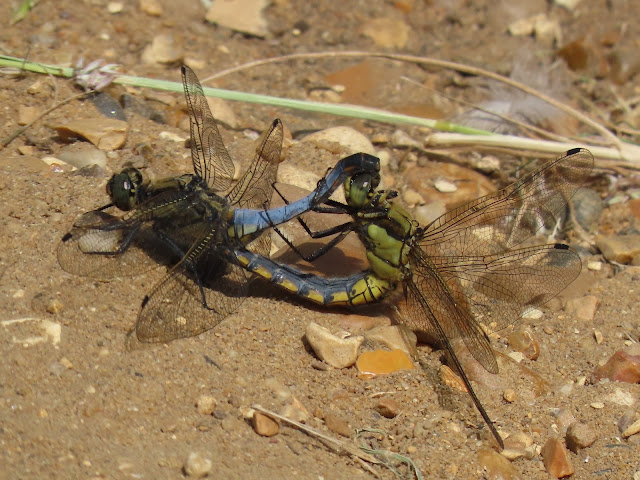After a week away in Sao Tome and Principe, it was back to birding in London for the rest of September. The heat wave had dissipated while I was away and the early mornings now have a chill to them. Normally that’s a good sign for some visible migration but the three early starts I had at Brent Reservoir failed to deliver. It’s definitely been an odd month for vis-mig in London with very few mipits or hirundines and no Siskins and barely enough species to fill more than one line in one’s notebook. Not that many people still use a notebook, it’s so much easier to use an app like eBird.
The waders have also changed, gone are all the Common Sands, replaced by increasing numbers of Snipe but there’s still a few Lapwing and Green Sands around. We even had a Dunlin for a few days. I’ve been hoping for some of the scarcer, or even rare waders this month so with wet weather forecast on Friday I decided to visit Rainham in the hope of connecting with something. I’ve still got a few holes in my year-list where Knot and Stints should be.
I arrived just after dawn and sure enough there was a light drizzle which occasionally turned a little heavier. I decided to walk the longer route via the barges and Coldharbour Point. I just reached the western end of Aveley Bay and stopped to have a scan when I heard a wader call somewhere over the river. I couldn’t immediately place the call and desperately scanned around. I did have an idea on its identity and it called again a couple of times giving the impression it was flying away from me. I checked on xeno-canto and was able to confirm that it was a Stone-curlew. I thought it might have been one of the East Tilbury birds but all three were reported as present later that morning. It was a shame not to have seen it but I was happy enough to count it just on the call.
There were a couple of flocks of Dunlin in the bay and I carefully checked each one but there was nothing different lurking among them. I headed into the reserve, a loop still not being possible due to boardwalk replacement. There was a flock of chats at the far end of the ouzel field, mostly Stonechats but with a few Whinchat in their midst.
.JPG) |
| Whinchat |
There has been an exceptional influx of Stonechat into London during the latter part of this month with record breaking numbers at Hampstead Heath and Richmond Park. They’ve also brought a few of their travelling companions with them: Dartford Warblers, with probably some more around that have yet to be discovered.
I spent a few more days at Brent where the highlight was two Rook flying over on Sunday morning. They’ve always been rare here but it’s been several years since I’ve seen one. On Monday I saw my first Redwing of autumn; there’s been a few odd ones reported across the capital but no sign of any notable movement yet.
On Thursday I was back at Rainham. There was a small overnight arrival of thrushes with a mixed flock of Blackbirds and Song Thrushes in the bushes along the road to the barges and a few more Blackbirds in the woods on the reserve. I walked up to Ken Barrett hide where there was a Ruff and a Green Sand. Migrating Swallows flew over the river wall and were accompanied by a couple of late Sand Martins. A few Skylarks and Meadow Pipits went over and there were a couple of large finch flocks.
For the last day of the month I decided the Blue-winged Teal was too good a bird to miss so had an early start and arrived at Fairlop just before 8am. I headed down to the lake and soon located a likely looking duck asleep on the island. I met a couple of other birders from Romford who hadn’t found the bird yet so we went back to check out the dozy duck. Eventually it woke up and we could see it was our quarry. A Magpie spooked it and it flew onto the lake flashing its bright blue forewing. It was still distant and the light was pretty awful so I didn’t manage to get a decent photo but it was a good bird to see.
.JPG) |
| A lousy shot of a really smart Blue-winged Teal |
It’s just the sixth BW Teal for London and the first since 2000. The last bird that stayed more than a day was the one I found at Brent way back in 1995/96. And it brought up 180 species on my London year-list which was my minimum target for the year.
.JPG)
.JPG)
.JPG)
.JPG)

.JPG)
.JPG)
.JPG)
.JPG)
.JPG)
.JPG)
.JPG)
.JPG)
.JPG)
.JPG)
.JPG)
.JPG)
.JPG)
.JPG)
.JPG)
.JPG)
.JPG)
.JPG)
.JPG)
.JPG)
.JPG)
.JPG)
.JPG)
%20(4).JPG)
.JPG)
.JPG)
.JPG)
.JPG)
%20(5).JPG)
.JPG)
.JPG)
.JPG)
.JPG)
.JPG)
.JPG)
.JPG)
.JPG)
.JPG)
.JPG)
.JPG)
.JPG)
.JPG)
.JPG)
.JPG)
.JPG)
.JPG)
.JPG)
.JPG)
.JPG)
.JPG)
.JPG)
.JPG)
.JPG)
.JPG)
.JPG)
.JPG)



